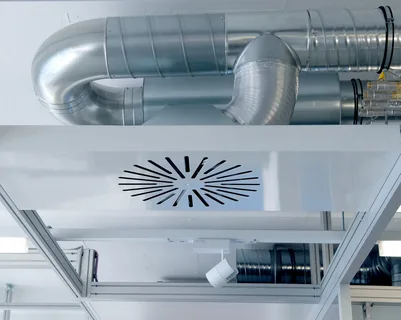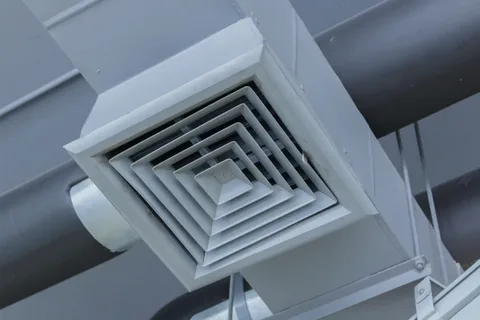A ventilation system is an essential component of any home, and it is responsible for maintaining indoor air quality by circulating fresh air throughout the living spaces. Homes can become stuffy, humid, and prone to mound growth without proper ventilation. In this blog post, we will look in-depth at ventilation-systems, including mechanical-ventilation-systems and energy-recovery ventilators (ERVs). We will explore the importance of ventilation, how these systems work, installation considerations, maintenance tips, and more.
What is a Ventilation-system and Why Is It Important?
A ventilation-system functions as the lungs of your home, enabling it to breathe by facilitating the exchange of indoor and outdoor air. Such systems are pivotal in managing humidity levels and play a critical role in mitigating indoor pollutants that could compromise the health and comfort of residents. Inadequate ventilation can trap various contaminants, ranging from volatile organic compounds emitted from paints and furnishings to everyday dust and dander. These trapped pollutants can exacerbate or lead to health problems, including but not limited to allergies, asthma, and other respiratory conditions.
A well-designed ventilation-system can significantly contribute to preserving your home’s structural integrity. By reducing excess moisture, it prevents the growth of mound and mildew, which can cause damage to building materials over time. A ventilation-system also ensures that smells and odors are quickly removed from the home, enhancing the overall living environment. With the increasing emphasis on creating energy-efficient, tightly sealed homes, the importance of a dedicated ventilation-system has never been more pronounced. It balances energy conservation with the equally crucial requirement for a healthy, breathable living space, demonstrating why understanding and maintaining your home’s ventilation-system is indispensable.
The Basics of Mechanical-ventilation-systems
Mechanical-ventilation-systems are engineered to ensure that your home enjoys continuous fresh air while simultaneously expelling stale, contaminated air. These systems efficiently manage air exchange by utilising fans and ductwork, which is fundamental in maintaining a healthy indoor environment. There are three primary types of mechanical-ventilation-systems: exhaust-only, supply-only, and balanced systems. Exhaust-only systems remove air from inside the house, thereby reducing indoor air pressure and allowing fresh air to enter through passive vents or leaks in the building envelope.
This type is often the simplest and least expensive to install but can lead to moisture problems in colder climates due to uncontrolled air infiltration. Supply-only systems, in contrast, pressurize the home by forcing in fresh air, which escapes through exhaust fan ducts or natural leaks. These systems can filter and sometimes preheat incoming air, offering a higher control level over the air that enters the home.
Balanced systems represent a more sophisticated approach, combining supply and exhaust functions to maintain balanced air pressure. By doing so, they offer an optimal solution for simultaneously removing stale air and introducing fresh, filtered air, which can be particularly beneficial for homes in extreme climates or those with specific air quality needs. Each type of mechanical-ventilation-system has advantages and considerations, making it essential to assess your home’s specific needs when choosing the right system.
Exploring Energy Recovery Ventilator (ERV)
Energy recovery ventilator (ERV) stands out as an innovative component within mechanical ventilation, offering a multifaceted approach to improving indoor air quality. These systems excel by introducing fresh air from the outside and capturing and utilizing the thermal energy and moisture from the exhaust air. This unique capability allows ERVs to minimize the energy losses associated with heating or cooling fresh air to match indoor temperatures, thereby enhancing the overall efficiency of home ventilation-systems.
Particularly advantageous in regions experiencing severe weather conditions, whether scorching summers or freezing winters, ERVs ensure that the indoor climate remains stable without exerting additional strain on heating and cooling systems. The core of an ERV system lies in its heat exchanger, where the outgoing indoor air warms or cools the incoming fresh air, depending on the season. Doing so significantly reduces the demand for HVAC systems, leading to noticeable energy savings over time.
ERVs can adjust humidity levels, a feature especially beneficial in areas with high moisture content in the air. This adjustment helps maintain a comfortable and healthy living environment, preventing issues related to excessive dryness or humidity. Integrating ERVs into home ventilation strategies underscores a commitment to sustainability, comfort, and health, making them an essential consideration for homeowners looking to optimize their living spaces.
Installation Considerations for Ventilation-systems
Selecting the right ventilation-system for your home involves more than just picking a model off the shelf; it requires careful consideration of various factors to ensure optimal functionality and efficiency. One of the first steps is determining the correct size of the system, which depends on your home’s square footage, ceiling height, and the number of rooms. An undersized system will only partially remove stale air or bring in enough fresh air, while an oversized system could lead to unnecessary energy consumption and increased costs.
Another crucial aspect to consider is the layout and design of your home. This influences where vents and ducts can be placed for maximum air distribution and minimal aesthetic disruption. Strategic placement of intake and exhaust vents can significantly impact the system’s effectiveness, preventing issues such as short-circuiting, where fresh air is immediately expelled before it can circulate throughout the home. The local climate also significantly influences the type of ventilation-system you might need.
For instance, homes in more humid climates may benefit from systems with dehumidification features to prevent excess moisture, which can lead to mound and mildew problems. Assessing the installation’s impact on your home’s energy efficiency is essential. Proper sealing and insulating ductwork can prevent energy losses, enhancing the system’s overall performance. Consulting with a professional HVAC installer can provide valuable insights into these considerations, ensuring your ventilation-system is tailored to your home’s unique requirements.
 Maintenance Tips for Your Ventilation-system
Maintenance Tips for Your Ventilation-system
Ensuring your ventilation-system operates effectively requires a proactive maintenance routine. Regularly inspecting and replacing air filters is crucial; a clogged filter reduces your system’s efficiency and can also degrade indoor air quality. Typically, filters should be replaced every three to six months, but homes with pets or high dust levels might need more frequent changes. It’s essential to keep intake and exhaust vents clear of obstructions. Debris, leaves, or snow can block vents, preventing proper air exchange and potentially causing system strain.
Inspect the ductwork for any signs of wear, leaks, or damage. Duct sealing or repairs may be necessary to maintain optimal system performance and prevent energy losses. Scheduling annual professional inspections is another critical component of a robust maintenance plan. A qualified HVAC technician can perform comprehensive system checks, including verifying that all mechanical components function correctly and ensuring the system is calibrated for maximum efficiency.
These inspections can identify potential issues before they escalate into costly repairs. Maintaining the area around your ventilation-system’s outdoor components is essential. Ensure there’s adequate clearance from vegetation or other objects that could restrict airflow or hamper the system’s efficiency. By adhering to these maintenance tips, you can extend the lifespan of your ventilation-system and ensure it continues to provide a healthy indoor environment for your home.
Comparing ERVs and Mechanical Ventilation System
When deciding between ERV and traditional mechanical ventilation system, weighing the specific benefits each offers is essential. With their ability to recycle energy from the exhaust air, ERVs present a more sustainable and cost-effective solution over time, particularly in extreme climates where heating and cooling costs can skyrocket. These systems are adept at maintaining comfortable indoor humidity levels, making them ideal for regions with significant seasonal weather variations. On the other hand, mechanical-ventilation-systems, encompassing exhaust, supply, and balanced options may offer a more straightforward and less costly approach to improving air quality.
While they efficiently exchange indoor and outdoor air, they do not inherently recover energy from the exhaust air, potentially leading to higher operational costs in energy-intensive climates. The choice between these systems ultimately hinges on individual priorities, such as upfront installation costs, ongoing energy savings, and specific climate considerations. Evaluating these factors in the context of your home’s environment and energy goals is crucial in making an informed decision that aligns with your long-term ventilation needs.
Ventilation-system Innovations and the Future
The landscape of home ventilation is rapidly evolving, with new technologies paving the way for more thoughtful, efficient ways to maintain indoor air quality. Among these advancements, intelligent ventilation-systems are gaining traction, offering homeowners unprecedented control over their home’s air quality. These systems integrate seamlessly with other smart home devices, providing real-time monitoring and adjustments to airflow based on the home’s occupancy and indoor pollutant levels. Another exciting development is the integration of AI into ventilation-systems.
These AI-driven systems can learn from your habits and preferences, adjusting ventilation rates to optimize energy use while ensuring the indoor air quality remains ideal. They can also predict changes in indoor air quality based on weather forecasts and adjust accordingly, providing a proactive approach to ventilation. Advancements in filter technology are making it possible to capture more pollutants kill pathogens and neutralize odors more effectively than ever before.
These innovations contribute to a new era of ventilation-systems that are not just about air exchange but also about creating a healthier living environment. The focus on sustainability also drives the development of more energy-efficient ventilation solutions, including solar-powered and low-energy consumption models, reducing the carbon footprint of maintaining good indoor air quality. As these innovations continue to emerge, the future of home ventilation looks promising, offering more intelligent, healthier, and more eco-friendly solutions for homeowners.
Conclusion
Navigating the intricacies of your home’s ventilation system is critical to safeguarding indoor air quality, a vital aspect of creating a comfortable and healthful living space. Choosing between an energy-recovery ventilator and a mechanical-ventilation-system hinges on various factors, including your home’s needs, climate, and energy efficiency goals. Regular maintenance, such as changing air filters and ensuring ductwork is sealed correctly, is integral to the system’s longevity and efficiency. Staying informed about advancements in ventilation technology can offer opportunities to enhance your system’s functionality and contribute to a more sustainable living environment.
FAQs
Q: What’s the ideal frequency for changing my home’s ventilation-system air filters?
A: For optimal air quality and system performance, replacing your air filters approximately every three to six months is recommended. However, the exact frequency can vary based on pet ownership, indoor dust levels, and the filter manufacturer’s specific recommendations.
Q: Is self-installation of a ventilation system feasible, or is professional installation advised?
A: While some individuals may possess the skills and knowledge required for a DIY ventilation system installation, professional installation is generally advised. A certified HVAC technician can ensure the system is installed correctly, efficiently operates, and meets all local building codes and regulations.
Q: Does upgrading to an energy-efficient ventilation-system affect utility costs?
A: Upgrading to an energy-efficient ventilation-system can significantly reduce your home’s energy consumption, lowering utility bills. Systems like ERVs can recuperate much of the energy typically lost during ventilation, enhancing your home’s overall energy efficiency and contributing to cost savings over time.
| Related Business Listings |
| Contact Directory |
| Local Business Profiles |



